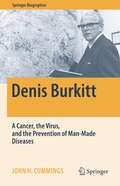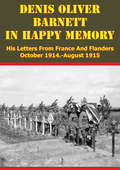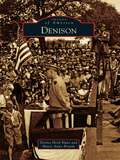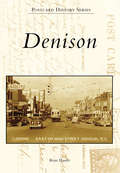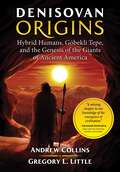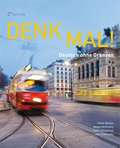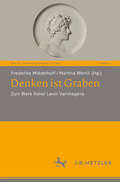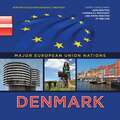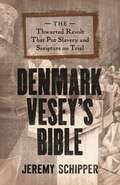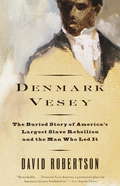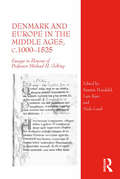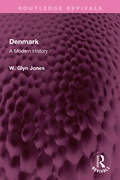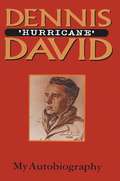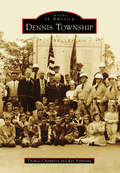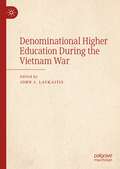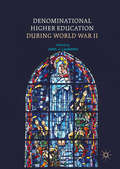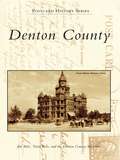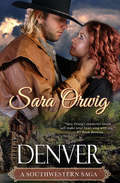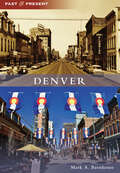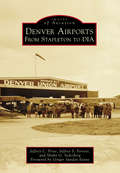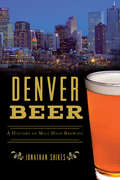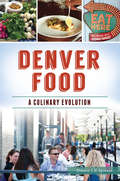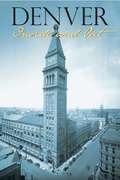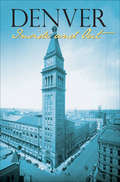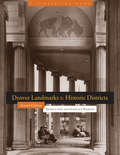- Table View
- List View
Denis Burkitt: A Cancer, the Virus, and the Prevention of Man-Made Diseases (Springer Biographies)
by John H. CummingsThis biography of Dr. Denis Parsons Burkitt, after whom the childhood cancer Burkitt's lymphoma was named, and who was a pioneer of the dietary fiber movement, paints a personal but holistic portrait of both the man and his life's work. Featuring excerpts from Dr. Burkitt's personal diaries, spanning seven decades from his boyhood to just before his passing, and extensive family archives, this book invites readers to follow Burkitt's journey through life and experience his tribulations and successes. Prof. John Cummings was a colleague of Dr. Burkitt and weaves the tale of his life through the lens of family, faith, and science. The journey takes Burkitt from his childhood in Ireland, a country undergoing major social upheaval, through his medical studies in Dublin, to army service in Africa in the midst of WWII and the independence movements that swept the continent in the following years. During his two decades spent in Uganda, working for the Colonial Medical Service, Burkitt made his first major contribution to cancer research - the characterization of Burkitt's lymphoma and its possible viral cause. Following his return to England in 1966, he turned his attention to the cause of ‘Western Diseases’ especially the role of dietary fibre in the prevention of disease and promotion of health. This earned him even wider international recognition and helped to inspire what is a vital field of research today. The book examines Burkitt's personal views of the world around him, including his experiences as a committed evangelical Christian who had been raised an Irish Protestant, and the challenges, both familial and cultural, that this elicited from and towards him and his scientific work. The lymphoma and later the fibre story propelled Denis into an orbit of worldwide travel, fame and many honours. An engaging speaker but man of great humility, always giving the credit for much of what he did to others, he left a legacy of evidence and ideas for the causes of cancer and prevention of disease from which we all now benefit.
Denis Oliver Barnett - In Happy Memory - His Letters From France And Flanders October 1914-August 1915
by Lieutenant Denis Oliver BarnettDenis Oliver Bartlett now lies in Poperinghe New Military Cemetery in Belgium, a bright young man who was cut down in his prime during the 1915: these letters home provide a lasting and fitting tribute to him.In August 1914, he enlisted in the Artists' Rifles: by October 27th he was in France. His own letters best tell the tale of what work he found to his hand and how he bore himself in that new world. It is enough to say here that upon going to the front he soon received a commission. He became 2nd lieutenant in the 2nd Batt. Leinster Regiment on January 1st 1915, and was promoted to be lieutenant on June 10th. All those who knew him speak with one voice in his praise. 'He was of the sort that don't know fear and would without doubt have greatly distinguished himself, had he been spared; he only wanted the opportunity. He was always wonderfully light-hearted and cheerful, so much so that I really believe he enjoyed warfare thoroughly, and the worse things were, the more cheerful he was. So 'twas no wonder he endeared himself to us all and that we all feel his loss as that of a dear brother and miss him at every turn.'On the 30th July he went back to Flanders for the last time. The rest is best told in the words of one of his fellow-officers. 'He was bomb officer and was in his element, leading all the bomb counter-attacks successfully and never getting a scratch. He could throw extraordinarily well and he used to frighten the Germans by getting tonite bombs into their trenches 150 yards away. That night (August 15th) Barnett had to start a working party at a place where our trench touched the German trench, with only twenty yards of unoccupied trench in between. He was warned to be careful, as the Germans had a machine gun and several rifles trained on the spot, but with his usual courage he got up on the parapet and from there directed the working-party. A flare showed him up and he was fired at immediately and one bullet hit him in the body.'
Denison
by Mavis Anne Bryant Donna Hord HuntDenison is known as "Katy's Baby," "The Infant Wonder," and "The Gateway City to Texas." Founded in 1872 as the first Lone Star stop on the Missouri, Kansas, and Texas Railroad, the city rapidly grew to 3,000 residents in its first 100 days. Citizens of the new town wanted a quality education for their children, and in 1873 they opened the first free, graded public school in the state. From Denison came many influential people, including Allied Forces supreme commander and U.S. president Dwight David Eisenhower, born here in 1890. The Perrin Air Force Base served as an important military training facility from 1941 until the 1970s. Denison is now home to numerous industries and major providers of medical services, and the Denison Dam across the Red River has formed a major recreation area for local citizens.
Denison (Postcard History)
by Brian HanderDenison was founded in 1872, when the Missouri-Kansas-Texas (MKT) Railroad established a terminus just south of the Red River. The small town quickly grew to hold a prominent place in the 19th-century American West, and it prospered alongside the railroad, becoming the gateway to Texas from the North. Denison has the distinction of being the birthplace of Pres. Dwight Eisenhower, the site of the first free, graded public school in Texas, and home to beautiful Lake Texoma. This book features a diverse collection of postcard images and takes readers on a journey through Denison's colorful past.
Denisovan Origins: Hybrid Humans, Göbekli Tepe, and the Genesis of the Giants of Ancient America
by Andrew Collins Gregory L. LittleReveals the profound influence of the Denisovans and their hybrid descendants upon the flowering of human civilization around the world • Traces the migrations of the sophisticated Denisovans and their interbreeding with Neanderthals and early human populations more than 40,000 years ago • Shows how Denisovan hybrids became the elite of ancient societies, including the Adena mound-building culture • Explores the Denisovans’ extraordinary advances, including precision-machined stone tools and jewelry, tailored clothing, and celestially-aligned architecture Ice-age cave artists, the builders at Göbekli Tepe, and the mound-builders of North America all share a common ancestry in the Solutreans, Neanderthal-human hybrids of immense sophistication, who dominated southwest Europe before reaching North America 20,000 years ago. Yet, even before the Solutreans, the American continent was home to a powerful population of enormous stature, giants remembered in Native American legend as the Thunder People. New research shows they were hybrid descendants of an extinct human group known as the Denisovans, whose existence has now been confirmed from fossil remains found in a cave in the Altai region of Siberia. Tracing the migrations of the Denisovans and their interbreeding with Neanderthals and early human populations in Asia, Europe, Australia, and the Americas, Andrew Collins and Greg Little explore how the new mental capabilities of the Denisovan-Neanderthal and Denisovan-human hybrids greatly accelerated the flowering of human civilization over 40,000 years ago. They show how the Denisovans displayed sophisticated advances, including precision-machined stone tools and jewelry, tailored clothing, celestially-aligned architecture, and horse domestication. Examining evidence from ancient America, the authors reveal how Denisovan hybrids became the elite of the Adena mound-building culture, explaining the giant skeletons found in Native American burial mounds. The authors also explore how the Denisovans’ descendants were the creators of a cosmological death journey and viewed the Milky Way as the Path of Souls. Revealing the impact of the Denisovans upon every part of the world, the authors show that, without early man’s hybridization with Denisovans, Neanderthals, and other yet-to-be-discovered hominid populations, the modern world as we know it would not exist.
Denk Mal! Deutsch ohne Grenzen: Deitsch Ohne Grezen
by Tobias Barske Megan McKinstry Karin SchestokatNIMAC-sourced textbook
Denken ist Graben: Zum Werk Rahel Levin Varnhagens (Neue Romantikforschung #6)
by Frederike Middelhoff Martina WernliDie Schriften Rahel Levin Varnhagens (1771–1833) sind ästhetisch und thematisch komplex. Sie umfassen kleine Formen, u.a. Aphorismen und Lektürereflexionen, ebenso wie lange Tagebucheinträge und umfangreiche Briefwechsel mit beinahe dreihundert Personen. Auszüge ihrer Texte wurden bereits zur Lebzeit Levin Varnhagens publiziert. Die im vorliegenden Band versammelten Beiträge zielen darauf ab, Rahel Levin Varnhagens Texte sowie die damit verknüpften weitreichenden Lektüren und Kontexte in ihren materiellen, ästhetischen, poetologischen und soziohistorischen Dimensionen zu erkunden und vor dem Hintergrund romantischer Konzepte und epistolarer Kommunikationsformen zu diskutieren. Darüber hinaus gibt der Band Einblick in ausgewählte Handschriften (Tagebuch A) sowie in ein bislang unpubliziertes Ausgabenbuch der Romantikerin.
Denmark (Major European Union Nations)
by Heather DocalavichDenmark is a peaceful northern country that joined the EU in 1973. From the Vikings to the modern day, Denmark has a long history. Today, Denmark is a very environmentally conscious nation with a lot going on. It also must figure out how to deal with issues of immigration and the global recession as it looks to the future. Discover more about this exciting, modern nation!
Denmark Vesey's Bible: The Thwarted Revolt That Put Slavery and Scripture on Trial
by Jeremy SchipperA timely and provocative account of the Bible&’s role in one of the most consequential episodes in the history of slaveryOn July 2, 1822, Denmark Vesey, a formerly enslaved man, was hanged in Charleston, South Carolina. He was convicted of plotting what might have been the largest insurrection against slaveholders in US history. Witnesses claimed that Vesey appealed to numerous biblical texts to promote and justify the revolt. While sentencing Vesey to death, Lionel Henry Kennedy, a magistrate at the trial, accused Vesey not only of treason but also of &“attempting to pervert the sacred words of God into a sanction for crimes of the blackest hue.&” Denmark Vesey&’s Bible tells the story of this momentous trial, examining the role of scriptural interpretation in the deadly struggle against American white supremacy and its brutal enforcement.Jeremy Schipper brings the trial and its aftermath vividly to life, drawing on court documents, personal letters, sermons, speeches, and editorials. He shows how Vesey compared people of African descent with enslaved Israelites in the Bible, while his accusers portrayed plantation owners as benevolent biblical patriarchs responsible for providing religious instruction to the enslaved. What emerges is an explosive portrait of an antebellum city in the grips of racial terror, violence, and contending visions of biblical truth.Shedding light on the uses of scripture in America&’s troubled racial history, Denmark Vesey&’s Bible draws vital lessons from a terrible moment in the nation&’s past, enabling us to confront racism and religious discord today with renewed urgency and understanding.
Denmark Vesey: The Buried Story of America's Largest Slave Rebellion and the Man Who Led It
by David M. RobertsonIn a remarkable feat of historical detective work, David Robertson illuminates the shadowy figure who planned a slave rebellion so daring that, if successful, it might have changed the face of the antebellum South. This is the story of a man who, like Nat Turner, Marcus Garvey, and Malcolm X, is a complex yet seminal hero in the history of African American emancipation.Denmark Vesey was a charasmatic ex-slave--literate, professional, and relatively well-off--who had purchased his own freedom with the winnings from a lottery. Inspired by the success of the revolutionary black republic in Haiti, he persuaded some nine thousand slaves to join him in a revolt. On a June evening in 1822, having gathered guns, and daggers, they were to converge on Charleston, South Carolina, take the city's arsenal, murder the populace, burn the city, and escape by ship to Haiti or Africa. When the uprising was betrayed, Vesey and seventy-seven of his followers were executed, the matter hushed by Charleston's elite for fear of further rebellion. Compelling, informative, and often disturbing, this book is essential to a fuller understanding of the struggle against slavery.From the Trade Paperback edition.
Denmark and Europe in the Middle Ages, c.1000–1525: Essays in Honour of Professor Michael H. Gelting
by Kerstin Hundahl Lars Kjær Niels LundWhere medieval Denmark and Scandinavia as a whole has often been seen as a cultural backwater that passively and belatedly received cultural and political impulses from Western Europe, Professor Michael H. Gelting and scholars inspired by him have shown that the intellectual, religious and political elite of Denmark actively participated in the renaissance and reformation of the central and later medieval period. This work has wide ramifications for understanding developments in medieval Europe, but so far the discussion has taken place only in Danish-language publications. This anthology brings the latest research in Danish medieval history to a wider audience and integrates it with contemporary international discussions of the making of the European middle ages.
Denmark: A Modern History (Routledge Revivals)
by W Glyn JonesFirst published in 1986, Denmark seeks to show the way in which modern Denmark, with its high standard of living, its sense of an orderly society, and its tolerance, had emerged and been shaped since the beginning of the 19th century. It traces its political history, the emergence of political parties and the protracted struggle for parliamentary democracy in the face of a king determined to appoint his own ministers. It looks at the determination of the Danes after the financial repercussions of the Napoleonic wars and the territorial and economic losses resulting from the Schleswig-Holstein debacle in 1864 to win through and recoup their losses. Social changes are described in some detail, particularly in the twentieth century and attention is paid to the workings of the Danish welfare state. Appendices trace in broad outline the historical relationship between Denmark and its former colonies of Greenland and Faroe Islands, now both self-governing territories. This book will be of interest to students of history, geography, political science, sociology and cultural studies.
Dennis 'Hurricane' David: My Autobiography
by Dennis DavidThe memoirs of a World War II RAF flying ace who participated in the Battle of Britain and the Battle of France. Born in 1918, with family roots in a coal-mining village near Cardiff, Wales, Dennis &“Hurricane&” David had a very distinguished war record with the Royal Air Force, particularly during the Battle for France and the Battle of Britain. He also flew in the Burma campaign, and his postwar adventures included personally witnessing the 1956 revolution in Hungary. Written with candor and exciting detail of his aerial adventures, this autobiography covers his flying career until he retired in 1967.
Dennis Township (Images of America)
by Thomas Champion Ray RebmannDennis Township is more than a swampy, desolate locale tourists drive through to reach the beach at the Jersey Shore. It is actually eight unique communities, stretching from the Garden State Parkway to the east to Delaware Bay and Cumberland County to the west. Dennis is farmland and forests of oak and pine. Meadows teem with wildlife, all just minutes away from busy beaches. Dennis Township is also about people, many of whom trace their roots back to before the American Revolution. It has a population of determined individualists, mixed with just enough "new blood" to sustain a vibrant community. Geography and people invigorate the township's eight hamlets, including Dennisville, Belleplain, and South Seaville, which were formerly independent towns but are now more regarded as signposts along the traveler's way. People have lived there for generations and will be living there still long after the tourists have moved on. This books tells more than one story, but all of the stories equally make Dennis Township the special place it long has been.
Denominational Higher Education During the Vietnam War
by John J. LaukaitisIn this follow up to Laukaitis' Denominational Higher Education During World War II (Palgrave 2018), this collection investigates connections between religion, student activism, and higher education to reveal the complexity of public reactions to the controversies around the Vietnam War. Historical treatments of how the Vietnam War generated tensions on campuses across the country remain centered on public universities such as University of California-Berkeley, Kent State, and University of Wisconsin-Madison. Missing from the historical analysis is how the Vietnam War affected the campuses of Christian liberal arts colleges. This work centers on how Christian liberal arts colleges across the landscape of the United States encountered the national crisis in relationship to their Christian tenets and how particular religious communities and student bodies responded to the war.
Denominational Higher Education during World War II
by John J. LaukaitisThis book examines how World War II affected denominational colleges who faced a national crisis in relationship to their Christian tenets and particular religious communities and student bodies. With denominational positions ranging from justifying the war in light of the existential threat that the United States faced to maintaining long-held beliefs of nonviolence, the multitude of institutional positions taken during World War II speaks to the scope of religious diversity within Christian higher education and the central issues of faith and service to God and country. Ultimately, Laukitis provides a particular lens to analyze the history of higher education during World War II through an examination of denominational institutions. The relationship between higher education, faith, and war offers depth to understanding the role of denominational colleges in articulating theological interpretations of war and their sense of responsibility as Christian liberal arts institutions in the United States.
Denton County
by Tricia Bolz Jim Bolz Denton County MuseumsThe history of Denton County, founded in 1846, has been well preserved through postcards. These images, produced from vintage photographs and artist renditions, reflect a time when communication through postcards was quicker, easier, and less expensive than writing a letter. Inside this book, readers are treated to charming snapshots of local history depicting churches, the downtown public square, businesses, public schools, the two newly created universities, railroad depots, trolleys, the earliest automobiles, and some of Denton County's most familiar town views and tourist attractions.
Denver (A Southwestern Saga #3)
by Sara OrwigUSA Today-Bestselling Author: In frontier Colorado, a woman risks her heart—and maybe her life—when she falls for an outlaw on the run… When Tigre Castillo is wrongfully accused of murder, he flees to Denver, leaving behind his outlaw past and his name. In Denver, he becomes Dan Castle, a man with dreams of a better future—and a fierce determination to have the woman his heart has always longed for. Mary O&’Malley has learned how to survive using wits and guile in a tough city ruled by men. When Dan&’s and Mary&’s paths collide, she finds herself surrendering—body and soul—to the only man with the power to destroy her… &“Sara Orwig's masterful touch will make your heart sing with joy.&”—RT Book Reviews
Denver (Past and Present)
by Mark BarnhouseDenver has evolved continuously since its 1858 founding, experiencing boom-and-bust cycles that have each left a mark on the cityscape. During the area's 21st-century growth spurt, impressive new buildings have arisen, but it is the charming old Denver r
Denver Airports: From Stapleton to DIA (Images of Aviation)
by Jeffrey C. Price Jeffrey S. Forrest Shahn G. SederbergOn the cusp of the Great Depression, Denver mayor Benjamin Stapleton pushed for the development of the first city-operated airport. Denver Municipal Airport opened in 1929 with three hub airlines. While Stapleton would be honored to later have the airport named after him, by the mid-1980s, the name Stapleton had become synonymous with congestion, flight delays, and frequent closures when the snow moved in. To solve the problem, Denver mayor Federico Peña envisioned a massive new airport, but when Denver International Airport (DIA) opened in 1995, its three hub airlines had whittled away to just one, and critics warned of dire consequences. Yet the airport persevered, and today, with its iconic tent roof, six runways, and 53 square miles of land, it stands amongst the most beautiful and busiest airports in the world. This is the story of three airports and how they brought the city from cow town to boomtown.
Denver Beer: A History of Mile High Brewing (American Palate)
by Jonathan ShikesBrewed in 1859 near what is now the heart of downtown, Denver's first beer quenched the thirst of fortune hunters following the gold rush. It lubricated the city's transformation from Wild West town to the Queen City of the Plains until Prohibition brought a sudden end to the brewing culture. By 1979, only the famed Coors brewery remained. But then something frothy happened. Brian Dunn, John Hickenlooper and many others began satiating locals with liquid gold. The craft beer movement blossomed. Now well over seventy breweries strong, it is filled with the same pioneering spirit and irrepressible optimism that the miners embodied. Journalist and author Jonathan Shikes captures the Mile High City's sudsy stories from then until now.
Denver Food: A Culinary Evolution (American Palate)
by Simone Fm SpinnerAllured by the gold rush, waves of German, Japanese, Chinese and Italian immigrants brought their culinary proclivities to the American West. The early sophistication of saloons followed, and Denver's gastronomic landscape experienced a tremendous culinary evolution spanning sixteen decades. Dating back to the late 1800s, My Brother's Bar doesn't have a sign and doesn't need one, serving up history along with delicious hamburgers. Established in 1985, nonprofit Denver Urban Gardens operates more than 155 community gardens across the metropolitan region. Ahead of the curve, Chef Ryan Leinonen set the city on fire with the New Nordic trend more than a decade ago when he opened Trillium Restaurant. With these stories and more, author Simone FM Spinner follows the journey from dreams of gold to fine dining, and Denver has never been more delicious.
Denver Inside and Out
by Michael Childers Melanie Shellenbarger B. Erin Cole Azusa Ono Betty Jo Brenner Rebecca A. Hunt Jeanne E. Abrams Eric L. Clements Cheryl Siebert Waite Shawn Snow Marcia Tremmel GoldsteinDenver turned 150 just a few years ago--not too shabby for a city so down on its luck in 1868 that Cheyenne boosters deemed it "too dead to bury." Still, most of the city's history is a recent memory: Denver's entire story spans just two human lifetimes. In Denver Inside and Out, eleven authors illustrate how pioneers built enduring educational, medical, and transportation systems; how Denver's social and political climate contributed to the elevation of women; how Denver residents wrestled with-and exploited-the city's natural features; and how diverse cultural groups became an essential part of the city's fabric. By showing how the city rose far above its humble roots, the authors illuminate the many ways that Denver residents have never stopped imagining a great city. Published in time for the opening of the new History Colorado Center in Denver in 2012, Denver Inside and Out hints at some of the social, economic, legal, and environmental issues that Denverites will have to consider over the next 150 years.
Denver Inside and Out
by Jeanne E. Colorado Historical SocietyDenver turned 150 just a few years ago--not too shabby for a city so down on its luck in 1868 that Cheyenne boosters deemed it "too dead to bury." Still, most of the city's history is a recent memory: Denver's entire story spans just two human lifetimes. In Denver Inside and Out, eleven authors illustrate how pioneers built enduring educational, medical, and transportation systems; how Denver's social and political climate contributed to the elevation of women; how Denver residents wrestled with-and exploited-the city's natural features; and how diverse cultural groups became an essential part of the city's fabric. By showing how the city rose far above its humble roots, the authors illuminate the many ways that Denver residents have never stopped imagining a great city. Published in time for the opening of the new History Colorado Center in Denver in 2012, Denver Inside and Out hints at some of the social, economic, legal, and environmental issues that Denverites will have to consider over the next 150 years. Finalist for the 2012 Colorado Book Awards
Denver Landmarks and Historic Districts (Timberline Books)
by Thomas J. Noel Nicholas WhartonA Timberline Book Denver Landmarks and Historic Districts, Second Edition is the newest, most thorough guide to Denver’s 51 historic districts and more than 331 individually landmarked properties. This lavishly illustrated volume celebrates Denver’s oldest banks, churches, clubs, hotels, libraries, schools, restaurants, mansions, and show homes. Denver is unusually fortunate to retain much of its significant architectural heritage. The Denver Landmark Preservation Commission (1967), Historic Denver, Inc. (1970), Colorado Preservation, Inc. (1984), and History Colorado (1879) have all worked to identify and preserve Denver buildings notable for architectural, geographical, or historical significance. Since the 1970s, Denver has designated more landmarks than any other US city of comparable size. Many of these landmarks, both well-known and obscure, are open to the public. These landmarks and districts have helped make Denver one of the healthiest and most attractive core cities in the United States, transforming what was once Skid Row into the Lower Downtown Historic District of million-dollar lofts and $7 craft beers. Entries include the Daniels & Fisher Tower, the Brown Palace Hotel, Red Rocks Outdoor Amphitheatre, Elitch Theatre, Fire Station No. 7, the Richthofen Castle, the Washington Park Boathouse and Pavilion, and the Capitol Hill, Five Points, and Highlands historic districts. Denver Landmarks and Historic Districts highlights the many officially designated buildings and neighborhoods of note. This crisply written guide serves as a great starting point for rubbernecking around Denver, whether by motor vehicle, by bicycle, or afoot.
